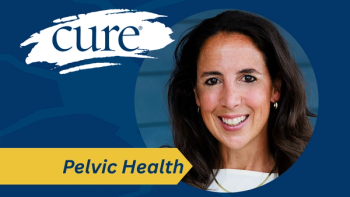
- Summer 2005
- Volume 4
- Issue 2
v4n2 - Reader's Forum
Teenage cancer diagnosis marked the path for this survivor.
It happens without an introduction—no handshake or tap on the shoulder. Soon enough it will have a name, written in permanent ink, both defining you and making you invisible. Soon you will know what it feels like to curse your own body. To beg for a clock that ticks backwards.
Silently, my cells had switched sides, from friend to foe, from protector to aggressor—mapping territory like a greedy warlord. Every bit of me was up for grabs, even the future I had envisioned.
I was a 17-year-old college student when I entered the lobby of Stanford University Medical Center. Once inside, the hospital swallowed me up. All of my senses were bombarded; walls blending one into another, the swish of doors opening and closing, massive machines that inhabit their own room—beeping, circling and spewing verdicts.
A red arrow pasted to linoleum guided my eye to the door where a doctor waited. Why had my gait become clumsy? Why couldn’t I sleep through the night? I stood half naked as a stranger examined the swelling that protruded from my right thigh. It wasn’t until the orthopedic surgeon excused himself and returned with a group of his colleagues that I became suspicious.
The very next morning, gloved hands prepared me for surgery. In a matter of hours, the mass attached to my youthful muscles was sliced and sent in pieces to pathology. The surgeon briefed my parents while I lay in recovery, still dizzy from the anesthesia.
I awoke in a private room, searching for something familiar, anything. I looked underneath the covers at my leg swathed in gauze. As I peeled back the textured cloth, dried blood clung to the bandages, trying to conceal what could no longer be hidden. The incision ran from my groin to my knee. How did an exploratory biopsy turn into this? I shook in disbelief. As my gaze focused, a heavy-set, bearded man took a seat on my bed. So he was the messenger.
The words “you have cancer” spit out of his mouth, bouncing off the walls and landing near me in a spray of shrapnel. I hid under the blanket. Perhaps he would leave my room and forget why he came.
My oncologist had neither time nor the inclination toward making small talk. He was a brilliant researcher who somehow escaped the windowless laboratory to come upstairs where patients were “subjects,” and “cocktails” were served intravenously. Our relationship was built on proximity. From the moment we met, the unspoken terms of our uneasy alliance became clear—he held all the power. I believed that if I remained pliable and relinquished control, I would live.
I was coaxed into a backless smock, my outstretched arm readied for the toxic drip. I was learning a new language: VAC, alopecia, rads, toxicity. This was a vocabulary that separated me from my peers, made me old. Life and death were converging at warp speed, biting at my heels.
There are actions one takes to survive (with body and spirit intact) that can seem inconceivable to those who live in the “well” world. Anger was seeping in, cracking my armor, igniting wildfires to escape unchecked. And escape they did. I was called a “bad patient,” non-compliant, belligerent. All of those descriptions were accurate. I perfected a scowl, an evil eye, and tapped into rage that frightened me.
But there were other truths about me that no one knew. I challenged myself to make it through the prescribed year of treatment, and when I crossed the threshold of the clinic for the very last time, tears spilled down my cheeks as I stroked my newly sprouted hair. I realized that I had not lost hope. I had not lost my ability to laugh. I could transcend this experience and move on—smarter, stronger, unafraid of what fate could conjure. I was a survivor.
Susan Nessim Keeney, founder and president of Cancervive (
Send your 700-word essays on cancer to
Teenage cancer diagnosis marked the path for this survivor.
By Susan Nessim Keeney
It happens without an introduction—no handshake or tap on the shoulder. Soon enough it will have a name, written in permanent ink, both defining you and making you invisible. Soon you will know what it feels like to curse your own body. To beg for a clock that ticks backwards.
Articles in this issue
over 20 years ago
The Dark Side of the Sun (and other radiation hazards)over 20 years ago
Radiation Timelineover 20 years ago
Genetic Interactionsover 20 years ago
Preventing Exposureover 20 years ago
v4n2 - Phases of Diseaseover 20 years ago
v4n2 - Monitoring CML: One Cell in a Millionover 20 years ago
v4n2 - Regaining Controlover 20 years ago
v4n2 - EGFR: Who Will Benefit from New Therapies?over 20 years ago
v4n2 - Power Bloggersover 20 years ago
v4n2 - Do you have something to say?



